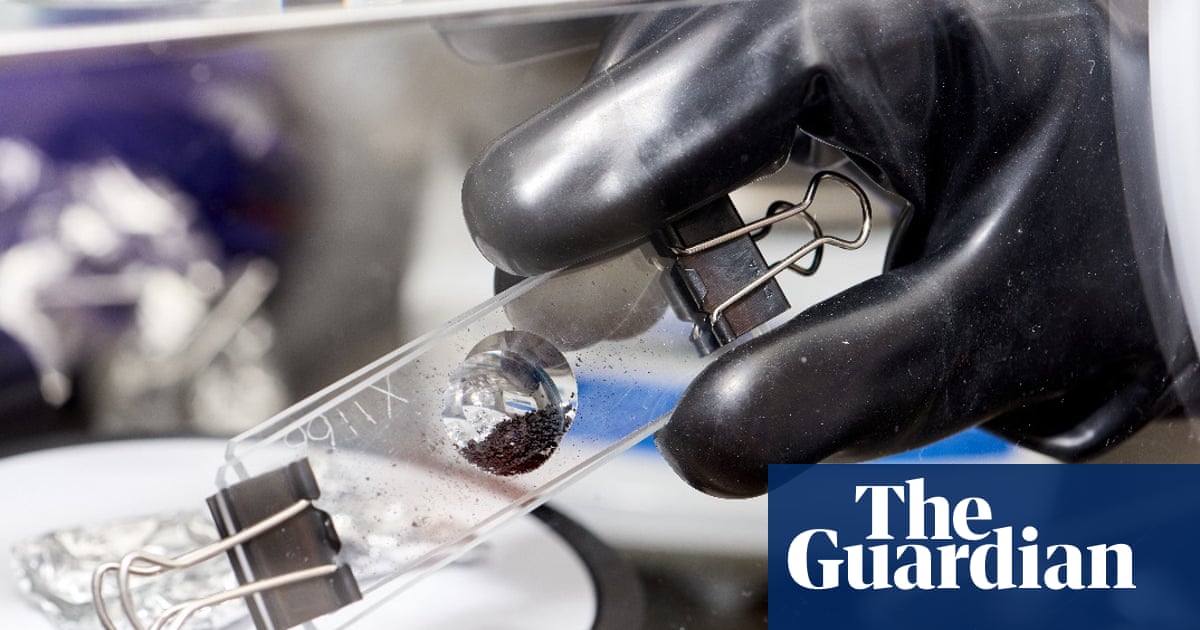Scientists have analyzed dark dust from the Bennu asteroid, which is approximately 4.6 billion years old. The results were described as “amazing”.

A sample of dark dust and granules, equivalent to a teaspoon’s worth, has been collected from an asteroid located 200 million miles away from Earth. It has been delivered to the Natural History Museum in London, where researchers are getting ready to uncover its mysteries.
The scientists at the museum were given 100mg of pure material that originated from the beginning of the solar system, estimated to be 4.6 billion years old. This material was collected by Nasa’s Osiris-Rex mission during its stop at asteroid Bennu in 2020 and brought back to Earth in September.
The spaceship briefly landed on Bennu, a 1-in-1,750 risk asteroid for potential collision with Earth within the next 300 years. It successfully collected over 60g of pristine material, the most significant quantity retrieved from space since the Apollo program.
Dr. Ashley King, a planetary scientist who will be studying the grains at the museum, described them as an incredible find that offers a glimpse into the beginnings of the solar system. She eagerly anticipates examining them and discovering what they can teach us about the early days of our solar system.
According to initial examinations conducted by NASA scientists, portions of the asteroid contained high levels of carbon and water, including some carbon bound in organic substances. Researchers anticipate studying the specimens for many years as they attempt to comprehend the origins of the solar system and determine if asteroids played a significant role in delivering water to Earth and other planets.
A crucial aspect of the investigation will involve studying the hydrogen isotopes present in Bennu’s water to determine if there are any similarities to those found in Earth’s oceans.
Beyond the questions of our cosmic origins are more existential matters, such as how to deflect or destroy asteroids that pose a potential threat to Earth. At a third of a mile wide, Bennu is far smaller than the six-mile-wide asteroid that spelled disaster for the dinosaurs, but it would still cause immense damage if it struck Earth.
During the initial two years of research at the Natural History Museum, the main focus will be on conducting non-invasive examinations, such as X-ray diffraction and electron microscopy, to gain knowledge about the mineral makeup and structure of Bennu. The sample contains grains ranging from millimeters in width to tiny particles of dust.
King stated that while it may not seem like a substantial amount, there is enough material to be utilized. The museum houses a top-tier assortment of meteorites and the employees are experienced in managing small quantities of highly valuable substances from the cosmos.
The particles and pieces of rock from Bennu were not exposed to extreme temperatures or pressure during their journey to Earth, unlike meteorites. This gives scientists a unique opportunity to study the asteroid in its original state.
“According to Prof Sara Russell, head of the planetary materials group at the Natural History Museum, this substance, equivalent to a teaspoon’s worth, will provide us with years of work as we analyze each tiny particle in order to comprehend its makeup and arrangement and discover any hidden insights.”
Source: theguardian.com



